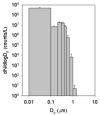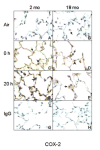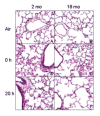Pulmonary effects of inhaled limonene ozone reaction products in elderly rats
- PMID: 17610924
- PMCID: PMC2772190
- DOI: 10.1016/j.taap.2007.05.003
Pulmonary effects of inhaled limonene ozone reaction products in elderly rats
Abstract
d-Limonene is an unsaturated volatile organic chemical found in cleaning products, air fresheners and soaps. It is oxidized by ozone to secondary organic aerosols consisting of aldehydes, acids, oxidants and fine and ultra fine particles. The lung irritant effects of these limonene ozone reaction products (LOP) were investigated. Female F344 rats (2- and 18-month-old) were exposed for 3 h to air or LOP formed by reacting 6 ppm d-limonene and 0.8 ppm ozone. BAL fluid, lung tissue and cells were analyzed 0 h and 20 h later. Inhalation of LOP increased TNF-alpha, cyclooxygenase-2, and superoxide dismutase in alveolar macrophages (AM) and Type II cells. Responses of older animals were attenuated when compared to younger animals. LOP also decreased p38 MAP kinase in AM from both younger and older animals. In contrast, while LOP increased p44/42 MAP kinase in AM from younger rats, expression decreased in AM and Type II cells from older animals. NF-kappaB and C/EBP activity also increased in AM from younger animals following LOP exposure but decreased or was unaffected in Type II cells. Whereas in younger animals LOP caused endothelial cell hypertrophy, perivascular and pleural edema and thickening of alveolar septal walls, in lungs from older animals, patchy accumulation of fluid within septal walls in alveolar sacs and subtle pleural edema were noted. LOP are pulmonary irritants inducing distinct inflammatory responses in younger and older animals. This may contribute to the differential sensitivity of these populations to pulmonary irritants.
Conflict of interest statement
Conflict of Interest: There are no conflicts of interest.
Figures









References
-
- Atkinson R, Hasegawa D, Aschmann S. Rate constants for the gas-phase reactions of ozone with a series of monoterpenes and related compounds at 296 +/- 2K. Int J Chem Kin. 1990;22:871–887.
-
- Augustyniak A, Skrzydlewska E. Antioxidative abilities during aging. Postepy Hig Med Dosw (Online) 2004;58:194–201. - PubMed
-
- Barnes PJ. Transcription factors in airway diseases. Lab Invest. 2006;86:867–872. - PubMed
-
- Becker S, Mundandhara S, Devlin RB, Madden M. Regulation of cytokine production in human alveolar macrophages and airway epithelial cells in response to ambient air pollution particles: Further mechanistic studies. Toxicol Appl Pharmacol. 2005;207:269–275. - PubMed
-
- Betsuyaku T, Kuroki Y, Nagai K, Nasuhara Y, Nishimura M. Effects of ageing and smoking on SP-A and SP-D levels in bronchoalveolar lavage fluid. Eur Respir J. 2004;24:964–970. - PubMed
Publication types
MeSH terms
Substances
Grants and funding
LinkOut - more resources
Full Text Sources
Other Literature Sources
Medical
Research Materials

